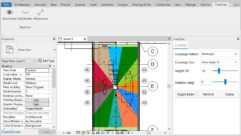What’s Bim To AV?
Building Information Modeling (BIM), a new process that’s changing how architects and contractors design and build, is headed our way.
Credit: aland
ELEMENTS OF BUILDING Information Modeling (BIM) have been around for several years, but it wasn’t until 2002 that AutoDesk formalized the idea in its product line and coined the term as it’s used today. It’s a concept that’s now starting to come into the mainstream consciousness of the architecture/engineering/construction (AEC) industry, and will start to affect AV in the near future. Why? One big factor is the General Service Administration’s recent mandate that all new public service projects utilize BIM methodology and technologies in the design phase. In addition, larger general contractors are using BIM to identify building design conflicts and collision points during the construction phase.
The definition of BIM starts with the 3D modeling of an entire building during the design phase. This includes the architecture, but also every element of the building, including mechanical, electrical, plumbing (MEP), structural, and ultimately any aspect of the building that requires physical coordination. Beyond that, the building elements are represented both in graphical and textual data so information like quantities, features, fire ratings, specifications, and documentation can be included in the building model. Not only that, but each consultant working on the project accesses the same model so coordination between building elements and disciplines is immediate. Conflicts reveal themselves as they’re created, and changing the 3D model in one place affects all of the other derived views of that area — plans, sections, elevations, and data.
Because of this, the information in the model can be used to solve space and system routing conflicts (duct runs, wall thicknesses, cable pathways, and yes, even projector mounting positions), resulting in fewer change orders during construction. Information can be exported to get accurate cost information during design without having to do the traditional material takeoffs from 2D drawings. In “4D” BIM systems, time can be incorporated to visualize and manage construction scheduling and progress. And built-in costing features make it a “5D” system in BIM terminology.
To the Obvious, and Beyond
Because it appears inevitable that AV providers will eventually deal with BIM, what does that mean? The most obvious benefit is the ability to coordinate and visualize physical aspects of our AV designs in the BIM model such as display size and location, projector mounting, loudspeaker locations, in-wall rack integration, lectern size and configuration, camera locations, sightlines (for projectors, cameras, and people), and a host of other visible AV-related building features. We should also be able to identify and coordinate conduit, cable pathways, rack layouts, and other infrastructure items. The advantage here for AV designers would be that we don’t have to draw as much to show why we need more space for equipment or why we need more ceiling height because the image won’t be large enough for most of the audience area to see. And there’s even greater potential for BIM in AV.
With interoperability between AV software and a BIM system, the effects of a control system on the whole space could be demonstrated and tested. Not only will we be able to see the control system interface and its effect on what might appear on a display, but both AV providers and their clients could see the interior and lighting designs (including the effect of lighting presets) during the design phase. Maybe even auralization capability could be linked into the BIM for both large and small room designs. DSP systems could be simulated in the BIM environment because it’s all in a software model to begin with.
Beyond the design and construction phases, the AEC industry sees building management of real facilities as part of BIM’s potential. This could range from real-time building automation control to product and system lifecycle cost and maintenance information management. For AV, the BIM model could include fully populated racks, plus projectors and other physically mounted devices in rooms. Each device could be accessed for product manuals and operational procedures and even real-time configuration and control. Traditional 2D system as-built drawings could be accessed through the BIM space as well.
The Price?
The potential of BIM is high, but so is the level of development and adjustment required for both the AV and AEC industries to fully utilize it. Initially, BIM is likely to realize its potential construction cost savings at the expense of design cost to some degree. Despite the idea that editing a single 3D building view updates the dozen other 2D views it affects, the learning curve and the maturity of BIM software may mean that it will take more time to use BIM at first. This would result in either higher fees for architects or tighter sub-consultant fee budgets (including AV, of course), or both.
In terms of AV designers’ work, however, much of the design work that we do for the electronic systems may not be significantly impacted in the short term. We’re already doing “virtual” system designs in DSP software and simulating user interface systems. System block diagrams for physical equipment interconnection may not benefit that much from 3D design, but the “5D” idea of integrated system component information and costing could be a real benefit for many designers and integrators. As BIM evolves in the longer term, it may be that our 2D design drawings and as-builts become more integrated into the graphical and database object-oriented components of BIM systems — eventually changing how we create and distribute system design information.
Where we may see more immediate impact is in the base building infrastructure part of our designs — equipment space allocation, seating layouts, peripheral equipment locations, acoustics, lighting, and cable pathways. For these design issues, we may have to interface more directly with the BIM system, which could require new software and training for many AV providers.
Part of the Solution
As BIM grows in the AEC industry and creeps into the pro AV world, it presents yet another area in which our industry needs to step up and make itself known. What makes BIM viable is standardization of interoperability between the software programs and files that are the lifeblood of the BIM process. Several organizations are already involved, including the International Alliance for Interoperability (IAI), which includes a subcommittee with the National Institute of Building Sciences (NIBS). The parameters being established include software interoperability standards, such as Industry Foundation Classes (IFCs), aecXML and gbXML, and a reliance on the National CAD Standard, which may soon have some impact on AV. An overarching National BIM Standard (NBIMS) is being developed for initial release this year.
Just as AV providers adopted CAD when architects started working in it, we’ll soon have to work with BIM because architects are starting to be required to work with it. And it can affect not just AV consultants and integrators, but AV manufacturers and technology managers, too. AV professionals need to educate developers, standard-makers, and users of BIM to make sure that the integration of AV into the BIM process isn’t oversimplified, or worse — ignored. Beyond the blue-sky potential of BIM for AV, the more mundane benefits of base building coordination that help other building trades can also help AV.
Tim Cape is a contributing editor for Pro AV, the principal consultant for Atlanta-based technology consulting firm Technitect LLC, and co-author of “AV Best Practices,” published by InfoComm International. He’s the current chairman of InfoComm’s ICAT consultant’s council, and an instructor and presenter in AV technology design and management. Contact him at [email protected].









